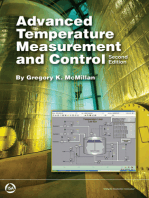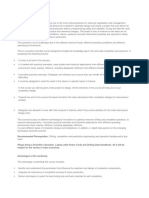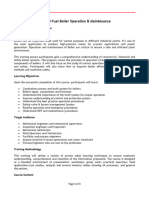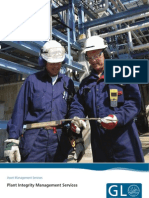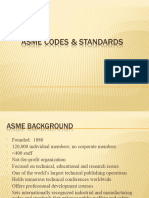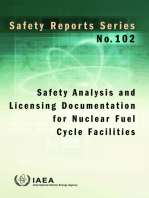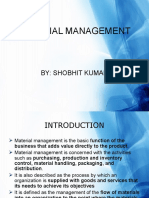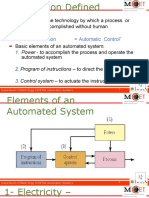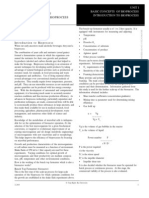Courses Content
Courses Content
Uploaded by
rjeesCopyright:
Available Formats
Courses Content
Courses Content
Uploaded by
rjeesCopyright
Available Formats
Share this document
Did you find this document useful?
Is this content inappropriate?
Copyright:
Available Formats
Courses Content
Courses Content
Uploaded by
rjeesCopyright:
Available Formats
Summary
This intensive course provides a comprehensive overview of relief and flare systems for oil and gas
processing facilities. The course begins with the need for pressure control/overpressure protection,
continues with the key engineering and design aspects including code considerations, and concludes
with selecting and sizing the components of a relief and flare system. The material of the course is
applicable to onshore field production facilities, pipelines, gas plants, terminals, refineries, and offshore
production facilities. The use of dynamic simulations for relief load determination is discussed and
demonstrated.
Intended Learning Outcome
On completion of the course delegates will:
Understand the purposes of relief and flare systems and their importance in safe operations
Understand the causes of over-pressure and the ways to control or mitigate them
Appreciate the process engineering principles underpinning relief systems
Determining the set / relieving pressures to meet operational, safety, and code requirements
Selection and sizing of other key components of a relief / flare system
Course Content
Day 1 :
Introduction to course
Typical Relief System
Purpose of relief and flare systems
Principle of process relief devices and process design of relief systems
Overview of typical relief and flare systems
Key components including:
Knockout drum
Flame arresters
Pressure Vacuum Relief Valves (PVRV)
Pressure Relief Valves (PRV)
Rupture / Bursting Discs
Flare Header and flare stacks
Day 2 :
Possible Relief Scenarios
Vessel and Tank Design
Safety implications
Causes of overpressure
Overpressure protection philosophy
Inherent safety
Source isolation and relief
Flammability
Explosions and BLEVE
Operational characteristics
Blowdown/depressurizing - purpose and design/operational considerations
Design and specification considerations for relief valves and header systems, including fluid
characteristics, services conditions, material selection, and header sizing
Environmental considerations
Day 3 :
Operational Considerations of Maintenance, Testing, Certification and Fluid Disposal
Selection and sizing of key components: knockout and seal drums, vent/flare stack, vent/flare tips, and
flare ignition systems
Defining need and quantity of purge gas
Codes and standards including good practices
Environmental considerations
Radiation considerations
Purge gas
Risk-based inspection and testing
Day 4 :
Determining Set / Relieving Pressures to Meet Safety and Code Requirements
Liquids, Pressure and Hydraulic relief
Flow of Liquids
Reynolds number, pressure drop in pipes
Compressible flow
Choked flow
Two-phase and Multi-phase Flow
Design and specification considerations for relief valves and header systems, including:
Fluid characteristics
Service conditions
Material selection
Header sizing
Determination of relief requirements and defining set point pressures
Blow-down / depressurizing: purpose, design and operational considerations
Flare gas recovery, smokeless flaring, and purge gas conservation
Operational and troubleshooting tips
Vent / flare stack,
Flare ignition systems
You might also like
- Refinery Plant OperationsDocument295 pagesRefinery Plant Operationsluv_y_kush357580% (10)
- Advanced Temperature Measurement and Control, Second EditionFrom EverandAdvanced Temperature Measurement and Control, Second EditionNo ratings yet
- Pressure Vessels: Design, Formulas, Codes, and Interview Questions & Answers ExplainedFrom EverandPressure Vessels: Design, Formulas, Codes, and Interview Questions & Answers ExplainedRating: 5 out of 5 stars5/5 (1)
- Process Safety Management (PSM) : General Awareness TrainingDocument18 pagesProcess Safety Management (PSM) : General Awareness Trainingrpercy0150% (2)
- Terminal Safety Guide PDFDocument18 pagesTerminal Safety Guide PDFByron CastanedaNo ratings yet
- Measurement and Control Basics, 4th EditionFrom EverandMeasurement and Control Basics, 4th EditionRating: 4 out of 5 stars4/5 (11)
- Green's TheoremDocument26 pagesGreen's Theoremjohn_doe_awesome100% (1)
- GR-TIEMS Operation Manual (6F2M1082) 0.04Document282 pagesGR-TIEMS Operation Manual (6F2M1082) 0.04iqbal100% (3)
- Relief and Flare SystemsDocument1 pageRelief and Flare SystemsalijadoonNo ratings yet
- This GL MACS Training Seminar Will FeatureDocument4 pagesThis GL MACS Training Seminar Will FeaturePriankMathurNo ratings yet
- Loc ProcessDocument76 pagesLoc Processuserscribd2011No ratings yet
- Ed Loss of ContainmentDocument47 pagesEd Loss of Containmentliamo88880No ratings yet
- Process Safeguarding - PSE02Document2 pagesProcess Safeguarding - PSE02Sarfraz AliNo ratings yet
- HSE - Design Codes - PlantDocument32 pagesHSE - Design Codes - PlantPaul Eke100% (1)
- Exclusion Zone Needs For High Pressure Testing 1721250540Document2 pagesExclusion Zone Needs For High Pressure Testing 1721250540Dheeraj Chowdary DhanekulaNo ratings yet
- 교재4) Mechanical Pe Thermal and Fluids Full Exam 2017Document167 pages교재4) Mechanical Pe Thermal and Fluids Full Exam 2017nikostudioNo ratings yet
- 18F42-ol-6-Air Compressors-Ehab AbowardaDocument2 pages18F42-ol-6-Air Compressors-Ehab AbowardaehabwardaNo ratings yet
- Process STD 601Document13 pagesProcess STD 601madx44100% (2)
- Mechanical Enginerring ProgramesDocument14 pagesMechanical Enginerring ProgramesMomar Talla DiawNo ratings yet
- Course Plan BCE 2174 Plant Operations Azharin S2 2015 2016Document10 pagesCourse Plan BCE 2174 Plant Operations Azharin S2 2015 2016Nia SyafiqqNo ratings yet
- OnQuestBroch Training Direct-Fired-Htrs Engineers 3-DayDocument6 pagesOnQuestBroch Training Direct-Fired-Htrs Engineers 3-DayAnonymous bHh1L1100% (1)
- Well Design Drilling and WorkoverDocument6 pagesWell Design Drilling and Workovers33d_2010100% (1)
- Flare and Blow Down StudyDocument4 pagesFlare and Blow Down Studyabuzar12533No ratings yet
- Gas and Fuel Boiler Operation & MaintenanceDocument3 pagesGas and Fuel Boiler Operation & Maintenanceahmed ramadanNo ratings yet
- Ansi Ans 511 Nuclear Safety Criteria Design of Stationary PressurizedDocument4 pagesAnsi Ans 511 Nuclear Safety Criteria Design of Stationary Pressurizedsarfraaz.shahNo ratings yet
- Mech - Stds. - 1Document65 pagesMech - Stds. - 1Amarendra Mani TiwariNo ratings yet
- Guidelines For The Protection of Pressurised Systems Exposed To Fire PDFDocument81 pagesGuidelines For The Protection of Pressurised Systems Exposed To Fire PDFhiginio.moro6182No ratings yet
- Pressure SafetyDocument34 pagesPressure Safetyisdemir073No ratings yet
- Course OutlinesDocument2 pagesCourse OutlinesLarbi HammounNo ratings yet
- Fundamentals of Natural Gas Measurement: OverviewDocument2 pagesFundamentals of Natural Gas Measurement: OverviewarslanadeelNo ratings yet
- Course Basics of Static Mechanical Equipment - BSM - Virtual Blended DeliveryDocument7 pagesCourse Basics of Static Mechanical Equipment - BSM - Virtual Blended DeliveryNjoku ChijiokeNo ratings yet
- Plant Integrity Management Services4224Document32 pagesPlant Integrity Management Services4224sajeed76740100% (4)
- 13.plant Integrity Management Services ExternalDocument32 pages13.plant Integrity Management Services ExternalGanesh PatilNo ratings yet
- Quality Control ReportDocument6 pagesQuality Control Reportrahman196011No ratings yet
- 1.1 ObjectiveDocument4 pages1.1 Objective安妮No ratings yet
- New Microsoft Word DocumentDocument3 pagesNew Microsoft Word DocumentAbdelrahmanAwadNo ratings yet
- Demonstrate and Apply Knowledge of Industrial Refrigeration System DesignDocument4 pagesDemonstrate and Apply Knowledge of Industrial Refrigeration System DesignVijay MummigattiNo ratings yet
- Pumps, Compressors, Turbines Operation, Maintenance & TroubleshootingDocument2 pagesPumps, Compressors, Turbines Operation, Maintenance & Troubleshootingm_alodat6144100% (2)
- Asme Code StandardsDocument34 pagesAsme Code StandardsPandu Pratama YudhaNo ratings yet
- FPSOs Training Course by Distance Learning - Course ContentDocument6 pagesFPSOs Training Course by Distance Learning - Course ContentCHO ACHIRI HUMPHREYNo ratings yet
- By The End of The Training, Participants Will Be Able ToDocument5 pagesBy The End of The Training, Participants Will Be Able Tos33d_2010No ratings yet
- Pipelines LOCDocument28 pagesPipelines LOCuserscribd2011100% (1)
- Design, Construction, Operation & Integrity: PipelineDocument4 pagesDesign, Construction, Operation & Integrity: Pipelineamr habibNo ratings yet
- Basic Subsea: Course Outline Who Should AttendDocument3 pagesBasic Subsea: Course Outline Who Should AttendanaattiaNo ratings yet
- Boilers & FurnacesDocument88 pagesBoilers & Furnacesnrnak50% (2)
- Approaches To Incinerator Selection and DesignDocument83 pagesApproaches To Incinerator Selection and DesignAbu Izzan Al BunyNo ratings yet
- Solution Manual For Introduction To Process Technology 4th Edition Thomas 9781305251472Document17 pagesSolution Manual For Introduction To Process Technology 4th Edition Thomas 9781305251472gregory100% (2)
- Control and Operation of Centrifugal Gas CompressorsDocument6 pagesControl and Operation of Centrifugal Gas CompressorsRoozbeh P0% (1)
- Relief Systems Vent SystemsDocument10 pagesRelief Systems Vent Systemsaugur886No ratings yet
- Steel Industry Gas SafetyDocument3 pagesSteel Industry Gas SafetyJaeman ParkNo ratings yet
- This Training Seminar Will HighlightDocument4 pagesThis Training Seminar Will HighlightJosé AntonioNo ratings yet
- Advamce Diploma in Industrial Safety & Security Management (FF)Document21 pagesAdvamce Diploma in Industrial Safety & Security Management (FF)Dr Shabbir75% (4)
- Project of Design by Group 3Document54 pagesProject of Design by Group 3etayhailu100% (4)
- Avoiding Leakage Seals+Sealing Systems Machinery+Piping Chemengonline.cDocument3 pagesAvoiding Leakage Seals+Sealing Systems Machinery+Piping Chemengonline.cAnonymous nw5AXJqjdNo ratings yet
- Hydro Testing Handbook: Principles, Practices, Applications, Formulas, and Common Q&AFrom EverandHydro Testing Handbook: Principles, Practices, Applications, Formulas, and Common Q&ANo ratings yet
- Safety Analysis and Licensing Documentation for Nuclear Fuel Cycle FacilitiesFrom EverandSafety Analysis and Licensing Documentation for Nuclear Fuel Cycle FacilitiesNo ratings yet
- Use of Periodic Safety Review for Long Term Operation of Nuclear Power PlantsFrom EverandUse of Periodic Safety Review for Long Term Operation of Nuclear Power PlantsNo ratings yet
- Post Weld Heat Treatment PWHT: Standards, Procedures, Applications, and Interview Q&AFrom EverandPost Weld Heat Treatment PWHT: Standards, Procedures, Applications, and Interview Q&ANo ratings yet
- Chemical Reactor Analysis and Applications for the Practicing EngineerFrom EverandChemical Reactor Analysis and Applications for the Practicing EngineerNo ratings yet
- Advanced Distillation Technologies: Design, Control and ApplicationsFrom EverandAdvanced Distillation Technologies: Design, Control and ApplicationsNo ratings yet
- Fill in The Blank With The Best Answer!Document4 pagesFill in The Blank With The Best Answer!Nur Septia Supiyanti SeptiaNo ratings yet
- 3x95 SM + 1x 50 RM NYY (TDS)Document1 page3x95 SM + 1x 50 RM NYY (TDS)jamilNo ratings yet
- Boiler: - IBR Boiler 22.75 Liters in CapacityDocument23 pagesBoiler: - IBR Boiler 22.75 Liters in CapacitySachin ParasharNo ratings yet
- Positioning Getting Open Without The BallDocument8 pagesPositioning Getting Open Without The BallAlexNo ratings yet
- Ar 2251 AnabDocument11 pagesAr 2251 AnabdhcastorenaNo ratings yet
- Cross Hole Sonic Logging APPLICATION WORD FORMATDocument3 pagesCross Hole Sonic Logging APPLICATION WORD FORMATQc C7No ratings yet
- Material Management: By: Shobhit KumarDocument7 pagesMaterial Management: By: Shobhit KumarPRIYANKNo ratings yet
- PDF Maquina de Anestesia Advanced Am 6000 CompressDocument240 pagesPDF Maquina de Anestesia Advanced Am 6000 CompressArnaldo AbadNo ratings yet
- (Ebook - PDF) Guide Du Karate, Aikido, Kendo, Judo - 134 Pages (Sport) (Arts Martiaux) (Combat) (Art Martial)Document134 pages(Ebook - PDF) Guide Du Karate, Aikido, Kendo, Judo - 134 Pages (Sport) (Arts Martiaux) (Combat) (Art Martial)Rafhael Sampaio100% (1)
- Safety Manual: Publication No. AA2205 - en 2019-01-09 Supersedes: 2017-09-22Document20 pagesSafety Manual: Publication No. AA2205 - en 2019-01-09 Supersedes: 2017-09-22Imane ObalahcenNo ratings yet
- SAUDI+ARABIA++-+Import+Guide+02+-+Energy+Efficiency+labeling+Ed +1 0Document3 pagesSAUDI+ARABIA++-+Import+Guide+02+-+Energy+Efficiency+labeling+Ed +1 0assadeqNo ratings yet
- Guia Tiva 2018Document14 pagesGuia Tiva 2018John Bryan Herrera DelgadoNo ratings yet
- Islami Bank Bangladesh Limited: Head Office Complex BranchDocument1 pageIslami Bank Bangladesh Limited: Head Office Complex BranchAfzal HossainNo ratings yet
- What Savitri Means To MeDocument12 pagesWhat Savitri Means To MeartwaniparasNo ratings yet
- Elements of AutomationDocument17 pagesElements of Automationcssp115No ratings yet
- NRG Battery Charger Data Sheet MSDDocument6 pagesNRG Battery Charger Data Sheet MSDMohamed SalamaNo ratings yet
- Method of Statement For Reinforced Cement Concrete WorkDocument8 pagesMethod of Statement For Reinforced Cement Concrete Workbatayi9833No ratings yet
- Cub Bio Lesson01 Activity1 Pop Density Worksheet AnswersDocument1 pageCub Bio Lesson01 Activity1 Pop Density Worksheet AnswersbjmandiaNo ratings yet
- Chapter - 2: Scada Functions 2.0 General RequirementsDocument21 pagesChapter - 2: Scada Functions 2.0 General Requirementskedar majethiyaNo ratings yet
- Projectile Mot WorksheetDocument1 pageProjectile Mot WorksheetzulkhairizulkifliNo ratings yet
- Introduction To Bio ProcessDocument2 pagesIntroduction To Bio Processstanley00109100% (1)
- For Exam (Chapter 2)Document7 pagesFor Exam (Chapter 2)Thi Han LinnNo ratings yet
- Read Me RSCDocument66 pagesRead Me RSCokij1209No ratings yet
- FD 70 eDocument4 pagesFD 70 eJuan Amanqui GarciaNo ratings yet
- Metals 10 00721 v2Document8 pagesMetals 10 00721 v2Juan Guzmán SantosNo ratings yet
- Lecture20 Drilled ShaftsDocument57 pagesLecture20 Drilled ShaftsAsia WardNo ratings yet
- IEC For Rayzon PanelsDocument4 pagesIEC For Rayzon PanelsNishant PandyaNo ratings yet
- Organic SynthesisDocument5 pagesOrganic SynthesisGuruKPONo ratings yet

